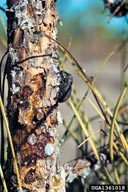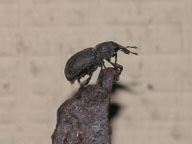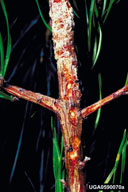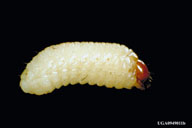Pitch-eating weevil
Pachylobius picivorus (Germar) (Coleoptera: Curculionidae)
Orientation to pest
The pitch-eating weevil, Pachylobius picivorus (Germar), is native pest of pines in the eastern United States that is especially important in southern states. This weevil's biology and damage are very similar to that of the pales weevil, Hylobius pales (Herbst). Damage occurs in cut-over stands of various kinds of pines, where adults feed either on the inner bark of small stems of the remaining trees or on planted or naturally regenerated pine seedlings. Seedling death is the most important kind of damage. Eggs are laid in green roots of recently cut stumps or those of dead or dying trees. Adults dig through soil to reach roots for oviposition. Larvae feed in the roots' cambial layer and eventually pupate there, after having constructed a cell of wood chips. Harvest creates abundant stumps, allowing population increase of this insect and focusing damage on cut-over sites. This weevil is one of several species associated with fungi believed to be the cause of decline of red pine (Pinus resinosa Sol. ex Aiton).
Hosts commonly attacked
This weevil feeds on various pines, but especially shortleaf (Pinus echinata Mill.), loblolly (Pinus taeda L.), and slash pines (Pinus elliottii Engelm.) in the southern United States, and Scots pine (Pinus sylvestris L.), in the northeastern/northcentral part of the country.
Distribution
The pitch-eating weevil is found throughout the eastern United States, but is most common from Virginia to Florida and west to Oklahoma and Texas.
Images of pitch-eating weevil
| Figure 1. Pitch-eating weevil, Pachylobius picivorus, on a pine stem (left), the adult's feeding site; and close up | Figure 2. Feeding on pine stem by adults of the pitch-eating weevil | Figure 3. Larva of pitch-eating weevil, extracted from a root, the larval feeding site | |
Important biological control agents related to this pest species
Very few specialized natural enemies have been recorded attacking pitch-eating weevil, the main one being Microctonus pachylobi Muesebeck, which attacks the adult stage.
Web links for information on pitch-eating weevil
Articles
- Walker, A. I. 1975. The biology and habits of the pales weevil, Hylobius pales (Herbst), and the pitcheating weevil, Pachylobius picivorus (Germar). Dissertation Abstracts International, B 35(8), 3962.
- Dixon, W. N. and J. L. Foltz. 1990. Pine reproduction weevils, Hylobius pales (Herbst) and Pachylobius picivorus (Germar) (Coleoptera: Curculionidae). Entomology Circular #332, University of Gainesville, Florida.
- Rieske, L. K. and K. F. Raffa. 1990. Use of a monitoring system to evaluate pesticide efficacy and residual activity against two pine root weevils, Hylobius pales and Pachylobius picivorus (Coleoptera: Curculionidae), in Christmas tree farms. Great Lakes Entomology 23: 189-193.
- Rieske, L. K. and K. F. Raffa. 1991. Effect of varying ethanol and turpentine levels on attraction of two pine root weevil species, Hylobius pales and Pachylobius picivorus (Coleoptera: Curculionidae). Environmental Entomology 20: 48-52.







